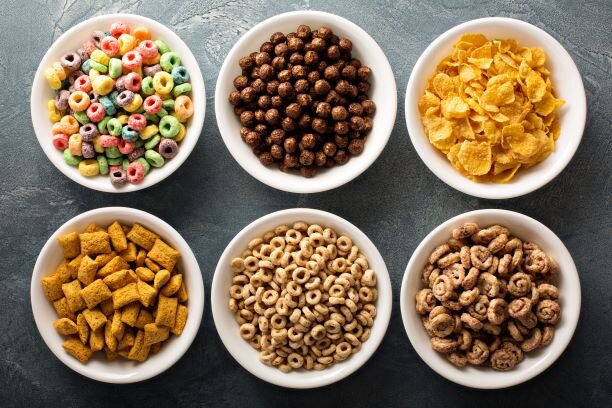Tips for Choosing Cereals
By Lizzie Streit, MS, RDN, LD
Cereal may be one of America’s most beloved breakfasts, but it’s not always the healthiest choice. Most options in a typical grocery store’s cereal aisle are laced with sugar, food dyes, and additives.
However, there are several other choices that are nutritious and can be incorporated into a healthy diet. Read on for tips and tricks for choosing a better cereal.
How to Choose Healthy Cereal
Here’s what to consider when looking for a healthy cereal:
Ingredients: Check the ingredients list to see what’s really in your cereal. The majority of ingredients should be recognizable and made from whole foods, such as whole grains, nuts, seeds, and dried fruits. Avoid artificial food dyes.
Added sugars: Avoid options that list one of the first few ingredients as sugar or any of its alter egos: high-fructose corn syrup, fruit juice concentrate, sucrose, glucose, and brown rice syrup, among others. If available, choose options that have no or small amounts of added sugars. You can always add fresh fruit at home for sweetness if desired. A good guideline is to choose cereals with less than 6 grams of sugar per serving.
Fiber: Look for cereals that have at least 5 grams of fiber per serving. Fiber promotes satiety and helps blunt spikes in blood sugar. Cereals made with nuts, seeds, or whole grains, like shredded wheat, oats, or bran flakes, are typically high in fiber. Oat-based muesli is a particularly high-fiber option that’s usually low in sugar.
Protein: Getting enough protein at breakfast is important for staying full in between meals and energized throughout the morning. Most high-sugar, low-fiber cereals are also low in protein. Look for options that have over 5 grams, and preferably closer to 10 or more grams, of protein per serving.
Other Tips
After you find a healthy cereal, there are a few other things to keep in mind. Take a look at the serving size on the nutrition facts panel. A lot of cereals have a fairly small serving size, around ¾ cup, but most people usually eat a cup or more at a time. It’s not always necessary to stick to the small serving size, but you need to take it into consideration when assessing the fiber and sugar contents of your portion. Be mindful of how much cereal you pour into your bowl.
There are several cereal add-ins that can boost the nutrition of your meal. For some additional protein, serve cereal with low-fat cow’s milk. Unsweetened nut or soy milks are also good options. Add fresh fruit for extra fiber and nuts or seeds for protein and healthy fats. You can also use cereal as a topping for Greek yogurt, a nutritious combo to enjoy for a meal or snack.
Note from Healthy For Life Meals: If you struggle with eating a healthy breakfast, let us help! Our breakfasts include a variety of nutritious foods and plenty of protein and fiber, so that you can start your day on a healthy note. Check out our traditional and vegetarian menus, and order today for fresh, healthy meals next week.

